As soon as the first batch is out of the oven, the sneaky raids start… After all, it is a hopeless mission to keep cinnamon baking a secret. Soon, the smell has spread through the entire house, reminding everyone of childhood, raspberry squash, and endless summer holidays.
Click here to skip straight to the recipe.
The powerful scent of cinnamon buns
It seems like I’m not the only one who
Then, there’s Dr. Alan Hirsch’s study in Chicago, which was a bit more risqué. A measuring device was connected to the male test subjects’ genitals to measure blood flow. The result? Freshly baked cinnamon buns were more stimulating than other scents such as Chanel No 5 or flowers.
Not that you needed any reasons for attack a butter-laden, cardamom-crunchy cinnamon bun, but sometimes we should be able to use science as an excuse.
So, go ahead and munch. If eating makes you kind and amorous, too, why not?
The history of the Swedish cinnamon buns
If you expect a fancy historical timeline over the glorious history of the Swedish cinnamon bun, I’m afraid you’ll be disappointed.
Cinnamon buns are are a relatively new invention.
The simple reason is that industrial yeast and convenient baking ovens are relatively new inventions as well.
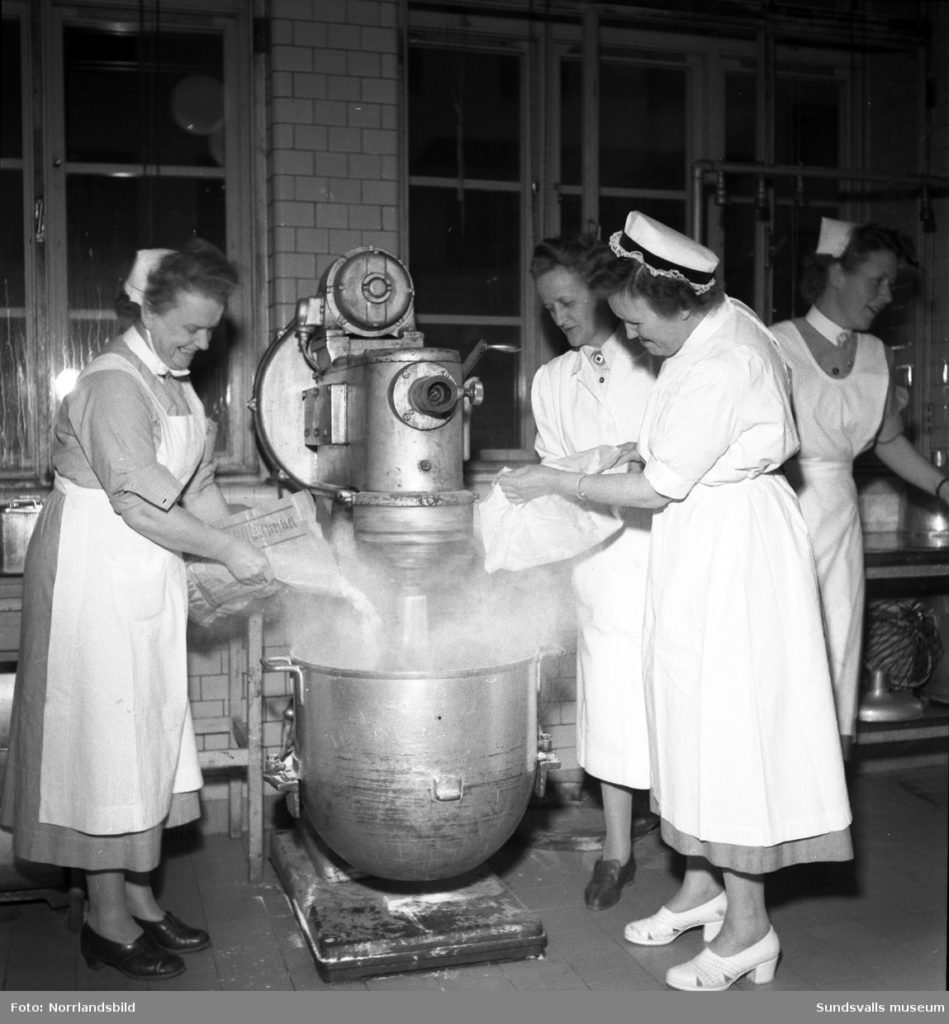
The ori gin story: sweet yeasted wheat bread
Let’s start by classifying cinnamon buns properly. Cinnamon buns, or
And the yeasted wheat bread makes an earlier appearance than our dear cinnamon bun. In my cookbook collection, the oldest source for finer “hwetebröd” is from Gustafwa Björklund’s 1849 cookbook. The dough is rolled to “round or oblong buns” and are brushed with yolk and dusted with sugar and cinnamon after baking.
Somewhat later, Hagdahl in his 1896 cooking bible
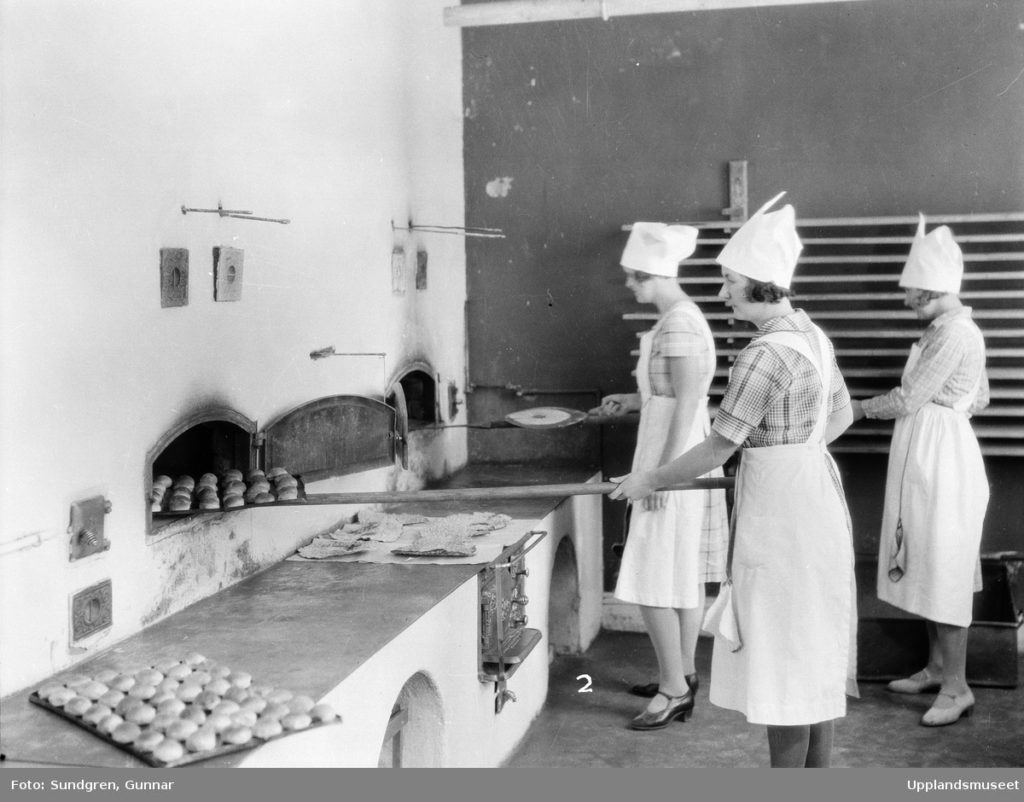
Nils-Arvid Bringéus mentions that “plain buns” were the most common and the cheapest, but there were also buns “with a few heavy sugar pearls and a small dollop of almond paste in the middle”.
Let’s move ahead a few years in the sweet yeast dough history. In 1924, Mellersted has a recipe in his Svensk Konditorbok for a coffee cake that is similar to a cinnamon bun — but it still baked as a wreath, instead of in individual buns. At this time, wreaths are more common, as they stay fresh for a longer period of time. Mellerstedt
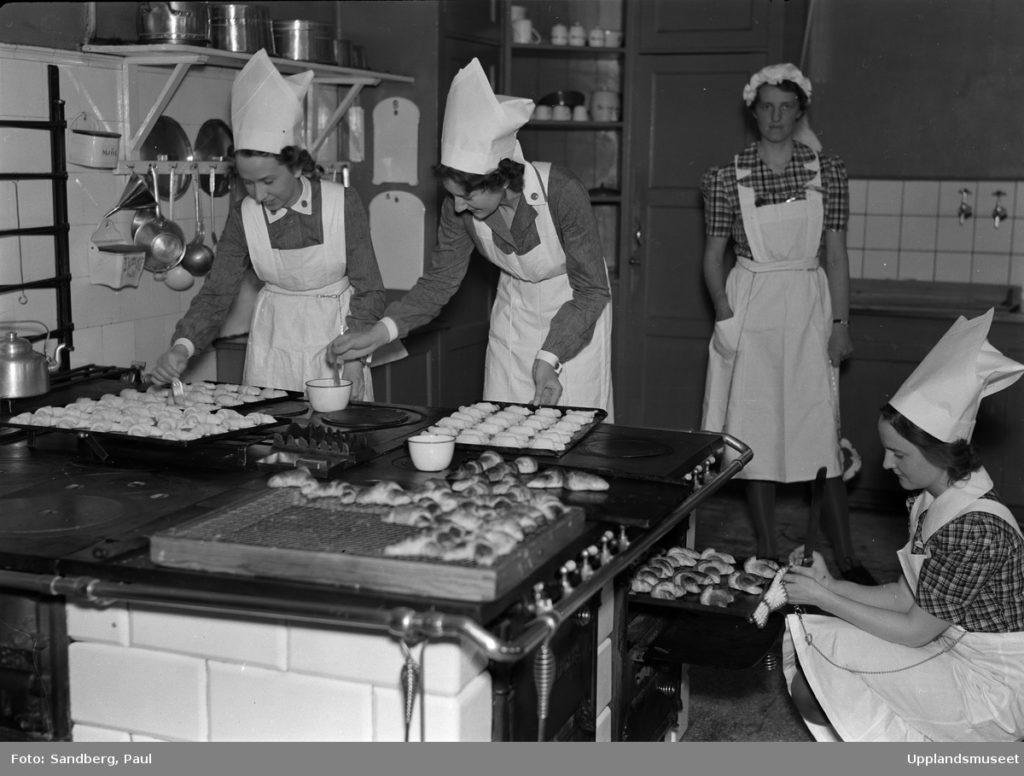
The cinnamon bun makes its entrence
In his
“After the first world war, they wanted variation with the yeasted wheat bread. The dough was rolled out and spread with an almond- and butter filling. Cinnamon mixed with sugar was sprinkled over, it was rolled up and baked after proving. Cinnamon had been used in bread in Sweden since the 16th century, but not mixed with sugar. This tasty, moist baked
Carl-Bertil Widell, En sockerbagare här bor i stadengood quickly claimed a spot in the heart of the people. The cinnamon bun has become the most popular Swedish baked good.”
Time-wise, Widell’s claim fits the recipe books I’ve consulted. The first description I’ve been able to find of something that we would recognize today as a cinnamon bun comes from Husmoderns 1000 recept by Kerstin Wenström, from 1924. Here, “shells” are described as a rolled yeasted wheat dough that is “lightly dusted with flour and then with cinnamon and sugar, well mixed”. Roll the dough, cut into pieces, brush with egg, and then bake. But modern bakers (and bun eaters) probably react at the lack of butter in the filling — just sugar and cinnamon, won’t that be dry?
It takes a while before the filled buns gain popularity. For example, Prinsessornas kokbok from 1932 and 1934 mention yeasted wheat dough, but it is still all about plain buns or filled wreaths. When Stora Kokboken is published in 1946, the buns have claimed their space – the dough cannot only be turned into wreaths and
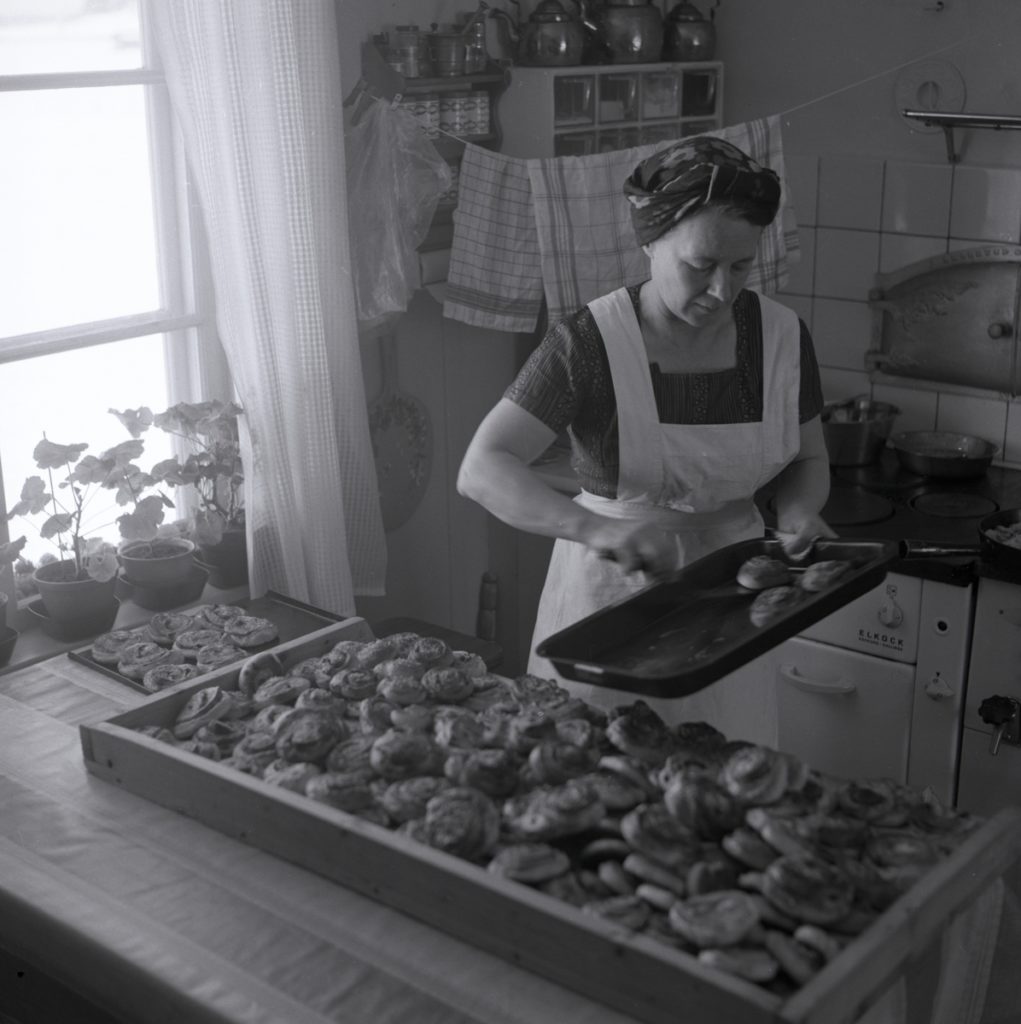
Cinnamon buns worthy of their own day for celebration
Cinnamon buns gain quickly in popularity. According to an article in the newspaper Svenska Dagbladet, the average Swede ate 10 kilos of cinnamon buns per year in 1960. This number fell to 4,8 kilos in 1999. So, maybe the declining numbers
Sure, you can see Cinnamon bun day as any commercial holiday. The bakeries add to the hype by recommending that you pre-order buns. Kiosks such as 7/11 and Pressbyrån pump out cheap prices and enough bakeoff-bun stench that the insulin starts to rush through your blood when you pass by on the street.
Or, maybe this is the day when we dedicate a bit of extra time and are fully present during the humble fika coffee break, shared with those who are close to us. Maybe you share a bun with someone who is used to having to eat their buns alone. Of course, it doesn’t have to be Cinnamon bun day for you to do that.
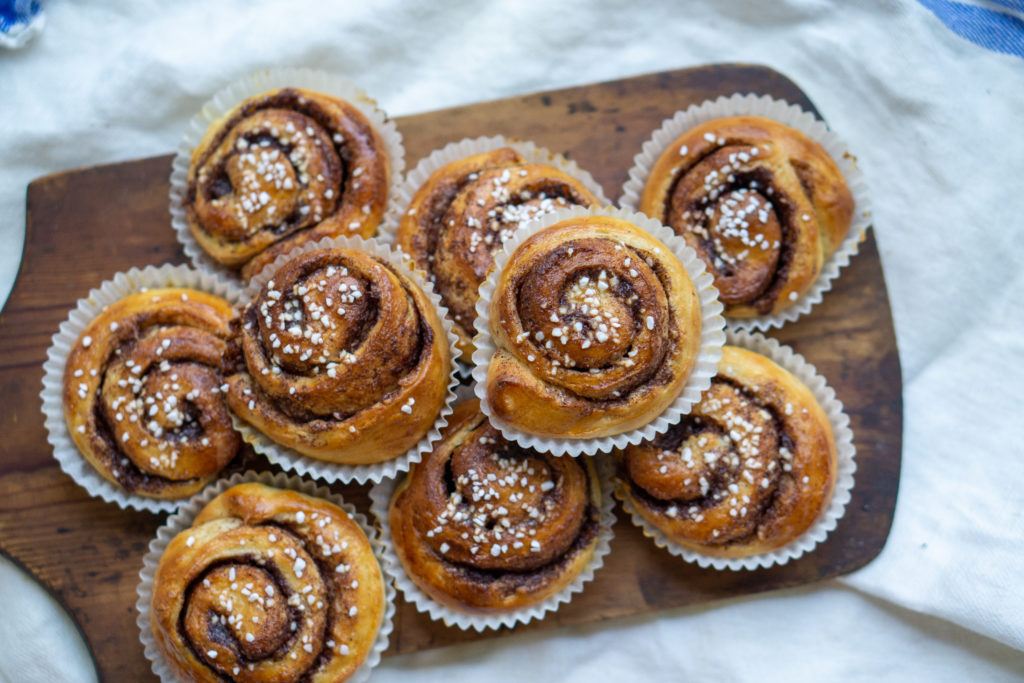
The components of the Swedish cinnamon bun
Let’s start with the most important thing: butter. If you’re vegan or can’t stand milk protein, then sure, use margarine. Otherwise, I simply can’t understand how anyone would skip the delicious butter flavor. I’d rather have a rare but buttery bun than a oft-appearing margarine bun.
The liquid is often milk. Baker Jan
When it comes to flour, you can experiment with various flour types such as spelt to get a deeper flavor. For the standard bun, I tend to go for the more protein-rich vetemjöl special, or strong flour. Vete-Katten agrees, while most recipes mention unspecified wheat flour. Bageri Petrus uses 900 gr flour and 250 gr spelt flour in their dough.
The yeast should preferably be fresh, but I’m aware that this isn’t as common outside of Sweden as it is here. Of course, you can substitute with dry yeast.
The dough is sweetened with sugar or white baking syrup. Salt. Cardamom. When it comes to cardamom, I have to sternly recommend that you use a pestle and mortar to grind the cardamom seeds yourself. The flavor is unbe
The filling of the cinnamon bun
A lot has happened since the 1925 shell buns with just cinnamon and sugar. The simplest filling consists of loads of butter mixed with sugar and cinnamon to taste. It is a classic that can’t go wrong. Of course, the filling can be varied indefinitely. Grated apples. Raisins. Vanilla sugar. Ann-Sofi Forsman has a cinnamon bun filling of equal measures sugar and butter (300 g each) and 15 grams each of vanilla sugar, cinnamon and cardamom. Daniel Lindeberg chooses powdered sugar instead of normal granulated sugar.
Then, what is the secret of an extra fine filling? Almond paste. Almond paste gives almond flavor and helps the bread stay moist for a longer period of time. Vete-Katten uses half almond paste, half butter, as well as cinnamon. Jan Hedh has a similar mix. I prefer the almond paste to be a bit more in the backseat for cinnamon buns, and mixes one part almond paste with two parts of butter, then adding cinnamon (and maybe a bit of cardamom or vanilla). Mix it well so it becomes a smooth filling.
Most standard cookbook recipes are stingy with the filling. Expect to use more butter than intended, and you’ll do fine.
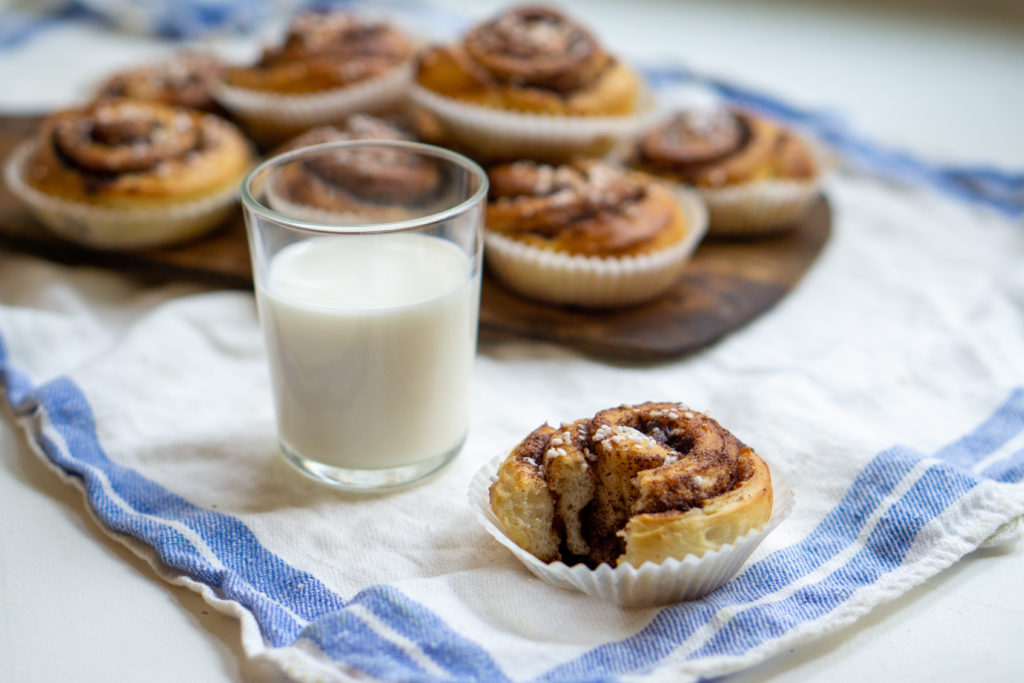
The appearance of the cinnamon bun
So, we’re down to the looks. An unavoidable question. I often make the classic shell shape, as it is pretty easy to get them to look neat. My mother cuts the bun dough in three “leaves” that she folds in an artful manner. A lot of bakers twist the dough and shape it into knots. No matter what you choose, a classic shell can’t be wrong. After all, the @-sign was called “the cinnamon bun” in Sweden when it first came.
Ever since the days of Gustafwa Björklund, we’ve brushed the dough with egg before it is baked. Jan
Pearl sugar is the most common decoration, for example at Brunkeberg, Petrus, Gateau och Vete-Katten. Jan
Daniel Lindeberg prefers to put the buns in paper baking cases. Not just because it is pretty, but also because it helps the filling to stay inside the bun instead of spreading on the baking tray.
The baking pro cess
The standard cookbooks and I disagree on the butter. Most recipes decree that the butter should be melted and added together with the milk. I find that the dough becomes nicer and needs less flour when you add it at room temperature. Vete-Katten, Brunkebergs
When we’re talking about the dough, there’s also the question of proving. Some, like Vete-Katten and Jan
Others prefer to let the dough prove in the cold. Of course, the longer time the dough is left to prove, the more flavour the dough can develop. You can also use less yeast when you have a longer proving time. But often, bun baking becomes time-consuming enough as it is. Even a humble standard dough can turn into a success when it is treated right. Let’s save the 12-hour dough for another time.
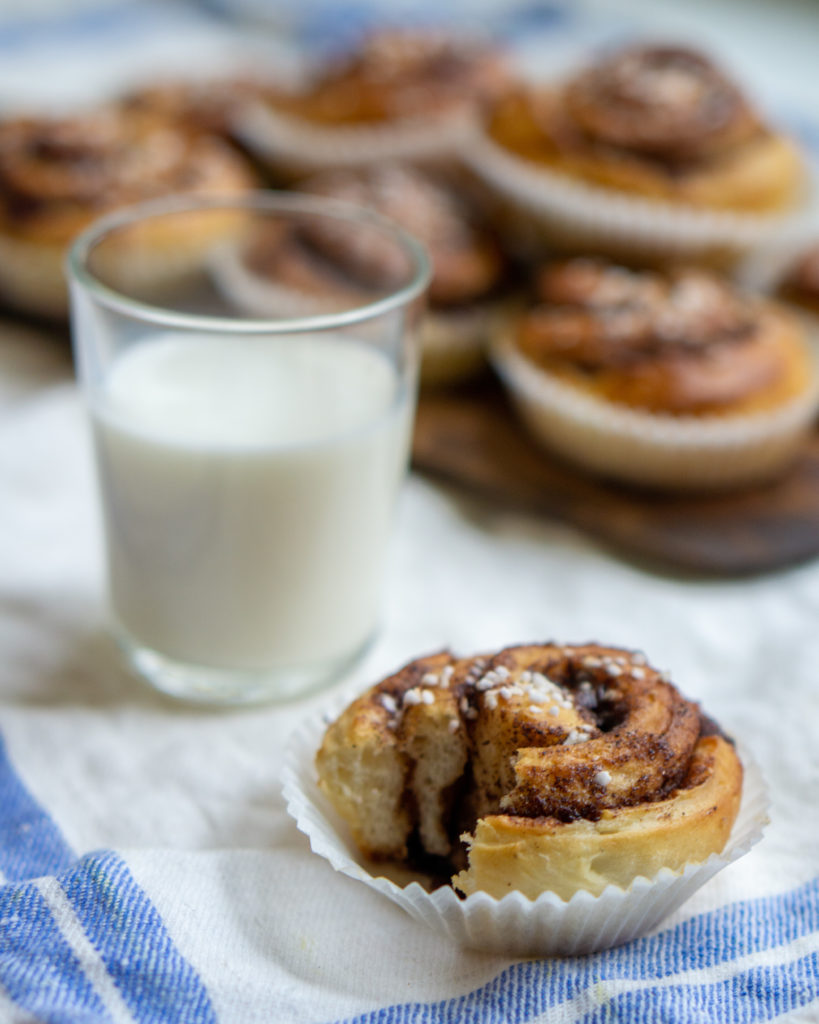
How to make delicious Swedish cinnamon buns
This recipe is quick and simple, based on trustworthy Vår kokbok. If you’re interested in something slightly more time-consuming, I’d recommend Martin Johansson’s recipe from Rute
Dough
5 dl (2 cups) milk
50g (1,7 oz) fresh yeast
1 tsp salt
1 dl (2/5 cup) sugar
2 tsp freshly ground cardamom (can be omitted)
ca 14 dl (ca 5 1/2 cups) flour, preferably strong flour (possibly somewhat more)
150g (2/3 cups) butter, room temperature
Filling
200g (7/8 cup) butter, room temperature
1 1/2 dl (3/5 cup) sugar
3-4 tbsp cinnamon
optional: vanilla sugar or cardamom
Decoration
1 egg
pearl sugar or chopped almonds
optional sugar syrup: 1 dl (2/5 cups) sugar + 1 dl (2/5 cups) water + 1/4 tsp vanilla powder
- Heat the milk until it is luke-warm (finger temperature, not warmer, or the yeast will die).
- Crumble the yeast in the bowl of a dough mixer and mix it with some of the milk. You can bake without a mixer, but then you need to be prepared to do a lot of kneading.
- Add the rest of the milk, sugar, salt, cardamom, and about 13 dl of the flour. Add the butter.
- Run the dough mixer on slow speed or knead the dough manually until it becomes shiny, smooth, and lets go of the bowl. In my mixer, it takes about 8-10 minutes. Add a bit more of the flour if the dough is too sticky. The dough is ready when you can take a small piece
is elastic between your fingers. Then the dough is gluten threads have developed. - Cover the dough with a towel or plastic foil and leave it to prove for 30 minutes until it is twice the size.
- When the dough proves, make the filling by mixing butter, sugar, and cinnamon together. You can also add a little dash of vanilla sugar or cardamom for extra flavor if you like.
- Knead the dough lightly on the baking table, cut it in half and roll it out with a rolling pin. For cinnamon rolls, I aim for a side of 25 cm (10 inches). If you want to twist the dough, you can make it longer and fold it two or three times.
- Spread the filling generously over the dough. For rolls, cut the dough with a knife or pair of scissors into 1 1/2 cm thick slices. Place them on a greased tray or in paper cups and cover with a towel or plastic foil. I often place about 12 per tray. Leave them to prove for 30 minutes.
- Set the oven to 250°C (480°F) while the buns are proving. If you want to brush the buns with a sugar syrup, let 1/2 dl water come to a boil with 1/2 dl sugar and a touch of vanilla powder.
- Brush the buns with egg and decorate with pearl sugar or almond.
- Lower the temperature to 225°C (435°F) and bake the buns for about 5-8 minutes on the middle rack of the oven. It often takes 8 minutes for my oven, but it will vary, so pay attention to the buns. They can quickly go from just right to overdone, so check on them. They should have a nice golden color on the top and the underside and not feel too doughy. If the buns still are doughy but have a nice color, place a sheet of aluminum foil over them for the rest of the baking.
- If you want to brush the buns with a sugar syrup, do it straight away when they come out of the oven.
- Eat and enjoy! The classic way to enjoy them is with a glass of milk, but you can
of course devour them any which way you like.
Suggestion
For a tasty almond filling, swap the sugar in the filling above for 100-125g (3,5-4,5 oz) almond paste. Flavor according to your taste.

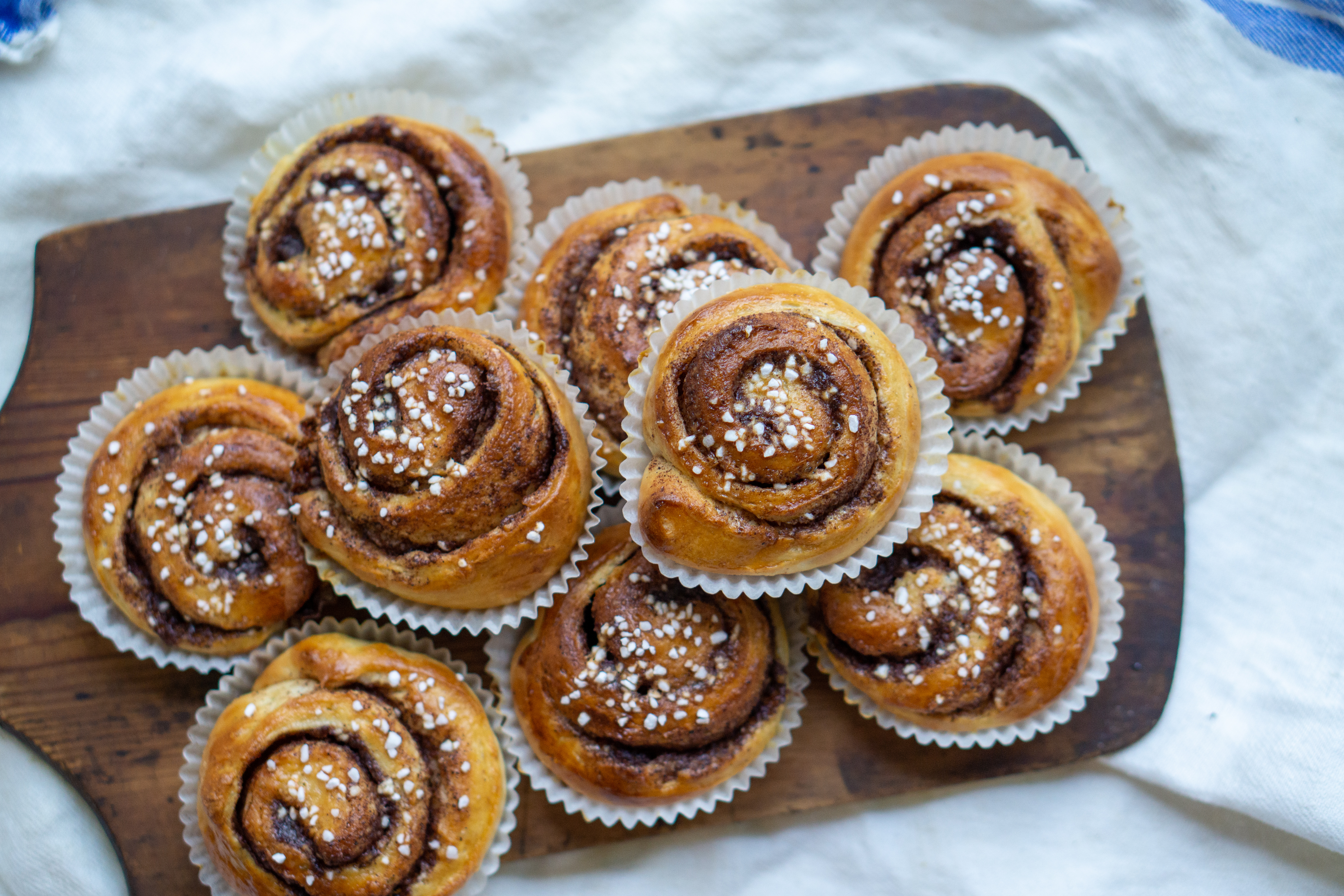

Cardamom should absolutely not be omitted. Otherwise these buns will not have the very characteristic that make them “Swedish” Cinnamon Buns. Omitting the cardamom will give you generic bastard cinnamon buns.
You’re so right! However, some people can’t stomach cardamom, so I’ll let them skip it. As far as I’m concerned, the more cardamom, the better…
Hi I am looking at the Lindeberg book and it says that there is no milk in the sweet dough. I am very confused as typically I use milk and almost all receive online, and also there include milk. Do you have an opinion on this?
Hi Guillaume, what an interesting question! It is curious that the recipes for non-professional bakers so often differ a lot from the bakers’ recipes…
I’d say that milk is the standard recommendation, at least for non-bakers. I make buns with milk, but have also used half milk, half water. In a book for Swedish baking and patisserie students (Moment och receptbok — Konditori & Bageri) the liquid in the dough can be “milk, water, cream, yoghurt, etc”. Most of my other baking books — Magnus Nilsson’s The Nordic Baking Book, Konditori Vete-Katten’s book, Gateau’s bread book, etc — recommend milk. I’d say you can use either.
I vaguely recall reading baker and author Jan Hedh saying that milk makes the dough softer and lets you use less flour, but don’t have a source on that… Looks like I’ll have to make a blind test!
For Americans reading this — “proofing” is another way to say “rising “ of the dough.
I will try the recipe and once it is done, I will inform you of the result.
That’s great Manie, I hope you’ll enjoy them! Let me know if there are any issues.
Thank you Linda, takes a while to get all my cooking lingo set to “American” 🙂
Hej Isabelle – I think you are right about ‘proofing’ being ‘American’ English. In UK English we would say ‘proving’ for the rise of dough. In UK English ‘proofing’ is a short version of ‘proofreading’ (which, as a copywriter, you’ll know all about 🙂 ). Bill Bryson wrote a very entertaining book, called Mother Tongue, about English in general, including some of the similarities and differences between different versions of the language.
Hi – must it be fresh yeast, or is dried yeast OK – I use Fermipan Red for making bread, so always have some around.
Hi Tony, you can use dried yeast instead! Just add it to the flour and let it sit for 10-15 minutes to let the yeast “wake up” before you add any liquids.
Fresk yeast can be hard to find in supermarkets in the UK, but I used to buy it from our local baker’s. 🙂